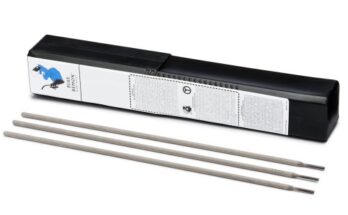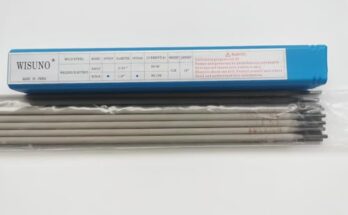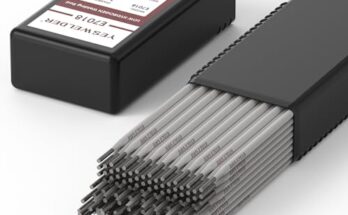Ready to delve into the world of welding? Let’s explore the versatile 6011 welding rod, its applications, and why it’s a favorite among welders. You’ll learn about its properties, uses, advantages, and limitations, becoming more confident in choosing the right welding rod for your next project.
The 6011 welding
rod is a type of electrode used in shielded metal arc welding (SMAW), often called stick welding. It’s a low-hydrogen, all-position, cellulose-sodium welding rod known for its exceptional penetration and ability to weld in various positions, even overhead. The “60” in its designation indicates its tensile strength (60,000 psi), while the “11” signifies its specific characteristics, including high cellulose content in its coating. This coating plays a crucial role in creating a shielding gas during welding, preventing atmospheric contamination of the weld pool. The sodium-containing compounds within contribute to easy arc initiation, important for beginners. Think of it like this: the coating is a protective shield, like a knight’s armor, protecting the weld from oxygen and nitrogen in the air which would otherwise make it weak and brittle. This makes 6011 exceptionally versatile and useful across numerous scenarios.
Key Features and Benefits of 6011
One of the most significant advantages of 6011 is its ease of use. Its cellulose-based coating produces a vigorous arc that’s easy to start and maintain, even with slightly rusty or dirty metal, making it a go-to for many beginners. It’s also an all-position rod, allowing welders to weld vertically, horizontally, and even overhead. This adaptability saves significant time and effort compared to rods restricted to flat positions. The deep penetration it provides is ideal for welding thicker materials or creating strong joints. This deep weld penetration means a stronger weld, crucial for applications where strength is paramount, like repairing farm equipment or constructing metal structures. Furthermore, its relatively low cost makes it an economically sound choice for many projects.
Comparing 6011 with Other Welding Rods
The 6011 rod stands out when compared to other welding rods like the 7018. While 7018 offers superior weld quality and strength, requiring meticulous surface preparation and a steadier hand, 6011 is forgiving and easy to manage, excelling in dirty, rusty, or less-than-perfect conditions. Think of it like comparing a high-performance sports car (7018) to a reliable truck (6011). The sports car offers superior performance but demands more skill, while the truck provides solid performance even on rough terrain, requiring less expertise. The 6011 is a workhorse; simple, dependable, and effective across a wider range of conditions than many alternatives.
Applications of 6011 Welding Rods
Welding Various Metals
6011 rods excel in welding mild steel, the most commonly used type of steel, across a wide range of thicknesses. Its ability to weld effectively on rusty or dirty steel surfaces makes it particularly valuable in repair work. Think of repairing a rusty gate or fixing a broken farm implement. The high penetration also makes it suitable for thicker materials where a strong, deep weld is essential. It’s not limited only to mild steel; with proper technique, it can also be used on some cast iron and other ferrous metals. Its versatility extends to various welding projects, from fixing fences to joining structural beams.
Ideal Welding Positions
As an all-position rod, 6011 simplifies welding tasks significantly. Unlike some other electrodes, it doesn’t require a specific welding position. This versatility proves invaluable in situations where access is limited or the workpiece is in an awkward position, common in industrial repair or construction sites. This feature eliminates the need for repositioning and increases efficiency. Imagine welding a pipe overhead; 6011 simplifies the task significantly compared to rods only suitable for flat or horizontal positions.
Common 6011 Welding Projects
6011’s strength and ease of use contribute to its popularity in numerous applications. It is frequently employed in general fabrication, construction, and repair projects. This includes creating structural components, reinforcing existing structures, and repairing damaged equipment. From the farm to the factory, this rod is a consistent choice among many welders for its strength and reliability. Common projects involve automobile repair, outdoor equipment maintenance, and even emergency repairs where a rapid and robust weld is essential.
Understanding the 6011 Welding Process
Setting Up for 6011 Welding
Before starting, ensure you have the appropriate safety gear, including welding gloves, a welding helmet with the correct shade lens, and protective clothing. Clean the area to be welded, removing any rust, scale, or paint. Then, grind down any sharp edges to help ensure a smoother weld. Choose the appropriate amperage for your welding machine and the thickness of the metal. This can vary based on the rod diameter; consult the manufacturer’s specifications for guidance. Proper setup is critical for success in any welding endeavor.
Techniques and Best Practices for 6011
Proper technique is paramount when using 6011 rods. Maintaining a consistent arc length and a steady speed are vital for a good weld. Avoid excessively long or short arcs, which can lead to porosity or lack of fusion. Start with a short, consistent arc, and maintain a steady hand. Proper welding involves a controlled motion, creating consistent welds. Learning correct posture and techniques from experienced welders or educational videos can greatly increase success.
Troubleshooting Common 6011 Welding Problems
Porosity (small holes in the weld) is a common problem, often due to an improperly maintained arc length, contaminated metal, or inadequate shielding gas. Lack of penetration may result from insufficient amperage or too fast a welding speed. Understanding the causes of these common issues allows for swift adjustments and prevents wasted materials and time. Proper practice and a methodical approach ensure success in avoiding these errors.
Safety Precautions When Using 6011 Welding Rods
Essential Safety Equipment
Welding with 6011, or any type of welding, requires a comprehensive safety approach. This begins with the right Personal Protective Equipment (PPE), including a welding helmet with the appropriate shade lens to protect your eyes from intense UV radiation, heavy-duty welding gloves to protect your hands from sparks and heat, and flame-resistant clothing to safeguard your body from burns and spatter. Eye protection is paramount, as intense UV radiation can cause severe damage to the eyes.
Ventilation and Environmental Concerns
Welding generates fumes and gases that can be harmful if inhaled. Always work in a well-ventilated area or use appropriate respiratory protection, such as a respirator with the right filters. This is crucial to avoid respiratory issues related to welding fumes. The environment needs to be well lit and free from fire hazards. These safety precautions are essential for a safe and productive welding experience.
Avoiding Common Hazards
Sparks and molten metal splatter during welding pose significant burn risks. Be mindful of your surroundings, maintain a safe distance from flammable materials, and use appropriate fire safety precautions. Avoid welding in enclosed or poorly ventilated spaces without proper respiratory protection. Understanding these potential risks and taking the appropriate steps to mitigate them is critical.
6011 Welding Rod Specifications and Selection
Understanding Rod Diameter and Length
6011 rods come in various diameters, typically ranging from 1/16 inch to 5/32 inch. The diameter choice depends on the thickness of the metal being welded and the amperage of the welding machine. Thicker metals require larger diameter rods, while thinner metals are suited for smaller diameters. Rod length is generally standardized at 14 inches. Understanding these specifications helps select the proper rod for the task.
Choosing the Right Amperage
The amperage setting on your welding machine directly impacts the weld quality. Too low an amperage leads to insufficient penetration, while too high an amperage can result in excessive burn-through. Manufacturer’s specifications for the specific 6011 rod diameter being used should be consulted to find the optimal range of amperage. Adjusting the amperage to match the metal thickness and rod diameter ensures proper welding parameters.
Factors Affecting Rod Selection
Several factors influence the choice of 6011 rod, including the type of metal being welded, the thickness of the metal, and the welding position. The desired weld quality, penetration, and overall project requirements also play a significant role in determining the appropriate rod selection. Experience and understanding of these factors lead to the most effective welding outcome.
Maintenance and Storage of 6011 Welding Rods
Proper Storage Conditions
Storing 6011 rods correctly prevents moisture absorption, which can compromise the weld’s quality. Keep the rods in a dry, sealed container to prevent moisture damage and maintain the integrity of the coating. High humidity environments can drastically reduce the weld quality. The optimal environment is dry, cool, and free from extreme temperatures. Appropriate storage extends the lifespan and reliability of these rods.
Inspecting Rods Before Use
Before each use, visually inspect the rods for any signs of damage, including cracks, rust, or significant coating defects. Damaged rods should be discarded to prevent compromised welds. Visual inspection ensures only high-quality rods are used, leading to higher-quality welds and ensuring the safety of the welder.
Preventing Rod Contamination
Keep rods clean and protected from dust, dirt, and moisture. Avoid touching the electrode coating or allowing it to come into contact with contaminated surfaces. Contamination can significantly impact the welding performance and may produce poor welds, requiring rework. Preventing contamination maximizes the lifespan and effectiveness of the rods.
Advanced Techniques and Applications of 6011
Welding Thin Materials with 6011
While 6011 is known for its deep penetration, it can be used with thinner materials, though it may require careful adjustment of amperage and welding speed. This often requires greater skill and experience to prevent burn-through. Mastering this technique unlocks more versatility in working with a broader range of materials.
Repairing Cast Iron with 6011
With the correct technique and preheating, 6011 can be used to effectively repair cast iron components. This may involve preheating the cast iron to a specific temperature to prevent cracking and ensure a sound weld. This application showcases 6011’s adaptability beyond basic steel welding.
Specialized Welding Applications
6011’s versatility extends to a variety of niche applications, including some stainless steel welding, though it’s generally not the first choice for superior stainless steel welding. It’s often utilized in emergency repairs where strength and rapid execution are crucial. Its robustness in diverse situations highlights its value in various fields.
Frequently Asked Questions
What is 6011 welding rod best for?
6011 welding rods are best suited for welding mild steel in various positions, particularly where deep penetration is required and the surface may be slightly rusty or dirty. Their ease of use makes them ideal for both beginners and experienced welders in repair work and general fabrication. Learn more about the advantages of deep penetration welds.
What amperage should I use with a 6011 rod?
The appropriate amperage for a 6011 rod depends on the diameter of the rod and the thickness of the metal being welded. Consult the manufacturer’s specifications for the recommended amperage range. Using the incorrect amperage can lead to poor welds. Learn more about adjusting amperage for different materials and welding scenarios.
Can I use 6011 on rusty metal?
Yes, one of the key advantages of 6011 is its ability to weld on rusty or slightly dirty metal surfaces. However, excessive rust or contamination may still require some surface preparation. Learn more about surface preparation techniques for optimal welding results.
What are the disadvantages of using 6011?
While versatile, 6011 rods produce welds with relatively lower tensile strength compared to other rods like 7018. Their welds can also have a higher slag inclusion rate. It’s important to be aware of these limitations for specific project needs.
Is 6011 good for beginners?
Yes, 6011 is often recommended for beginners due to its ease of arc initiation and forgiving nature. The strong arc is easier to control than some other electrodes, making it a suitable starting point for learning stick welding. Learn more about beginner-friendly welding techniques.
How should I store 6011 welding rods?
Store 6011 rods in a dry, airtight container to protect them from moisture, which can significantly affect the weld quality. Proper storage extends the rod’s lifespan. Learn more about preventing moisture damage to your welding rods.
What type of safety equipment should I use when welding with 6011?
Always use appropriate safety equipment, including a welding helmet with the correct shade lens, heavy-duty welding gloves, and flame-resistant clothing. Additionally, work in a well-ventilated area and consider using a respirator to prevent inhalation of harmful fumes. Learn more about welding safety and best practices.
Final Thoughts
The 6011 welding rod, with its versatility and ease of use, proves to be a valuable asset in the world of welding. Its ability to handle various metals, positions, and conditions, coupled with its relatively low cost, makes it a popular choice among welders of all skill levels. While it may not be the ultimate choice for every application, understanding its strengths and limitations allows for successful utilization in numerous projects. From simple repairs to complex fabrications, 6011 remains a dependable and readily accessible welding solution. Remember always to prioritize safety and practice proper techniques to ensure a successful and safe welding experience. So, equip yourself with the knowledge, gather your tools, and embrace the rewarding world of welding!


